A World-class Pure Groundwater City Kumamoto, Japan
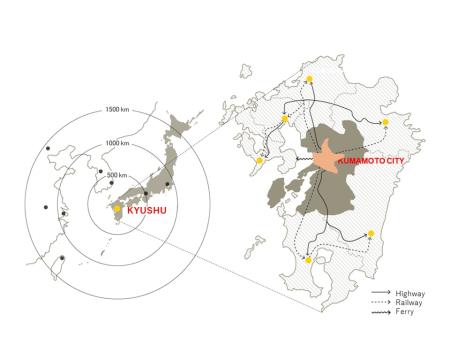 |
Location of Kumamoto City |
Kumamoto City is located in the center of Kyushu (a major island in the southwest region of the Japanese archipelago). It boasts the finest groundwater resources of any city in Japan, with all tap water supplied to its citizens sourced from groundwater. Kumamoto's clean and abundant groundwater is used for various purposes in society. It is the only city in Japan where groundwater is used as the only source for tap water for a population as large as Kumamoto's (740,000 people).
The Kumamoto Plain is also filled with rivers, springs, and other bodies of water that provide locals with resources for life and relaxation.
However, as the city expands and our industrial economy grows, decreasing rates of groundwater recharge have lowered the water table and pollutants like nitrate-nitrogen have harmed water quality. This presents risks to our local society and water environment.
To fix this, Kumamoto has been collaborating with other municipalities in the Kumamoto area on a variety of groundwater conservation projects.
Groundwater conservation in Kumamoto City began in 1973, when Kumamoto Prefecture and Kumamoto City collaborated over 2 years on the Groundwater Assessment in Kumamoto City and the Neighboring Region. What followed was the Groundwater Conservation City Declaration (March 1976) that was passed by the city council in response to protests against construction of apartments near the Kengun Suigenchi groundwater source. With the enactment of the Kumamoto City Groundwater Conservation Ordinance in 1977, Kumamoto established an organization for groundwater conservation by working together with the prefectural government and researchers to measure groundwater, understand how it is being used, and research the mechanisms behind groundwater flow through land use and soil surveys. We have also implemented a number of water saving programs for residents and water level conservation projects, including a rice paddy ground water recharge program and a project for maintaining watershed conservation forests.
These projects have been well regarded throughout the country, resulting in Kumamoto City being awarded the grand prize at the June 2008 10th Japan Water Prize and receiving the Water for Life Award from the UN in March 2013. Such independent, local, resident-led programs have garnered much attention, and the Suizenji-Lake Ezu springs and the Mt. Kinpo springs were both selected for the Heisei Top 100 Waters in June 2008. Kumamoto City will also be hosting the 4th Asia-Pacific Water Summit in April 2022, where heads of state, cabinet-level ministers, and leaders of international institutions will convene to discuss water-related issues.
The Origins and Processes Behind Our Groundwater
Kumamoto City - A World-Renowned Groundwater City
.jpg) |
The 11 municipalities of the Kumamoto Region |
Kumamoto City supplies its 740,000 citizens with tap water sourced completely from groundwater. Kumamoto is the only city in Japan with a population greater than 500,000 that has accomplished this, and similar cities around the world are extremely rare.
The Kumamoto Region covers 1,041 sq km to the west of the Aso Outer Mountain Ring. The region consists of 11 municipalities and is home to around 1 million people. Almost all tap water throughout this entire region is sourced from groundwater.
This means that communicating the importance of preserving our groundwater is of utmost importance, and these municipalities work together to conserve our groundwater. Kumamoto's efforts have received considerable attention from overseas, culminating in Kumamoto City being honored with the 2013 UN Water For Life Best Practices award.
The Kumamoto Region Water Cycle
It is estimated that there are about 1.4 billion cubic kilometers of water on Earth. Of this, 97% is seawater, and only around 3% is freshwater. Most of this freshwater exists as Antarctic and Arctic ice, and all the freshwater readily available to us in rivers and lakes amounts to just 0.8% of all the water on Earth. On the Earth's surface, water absorbs energy from the sun and evaporates. This water turns into clouds in the atmosphere, which create rain and snow that fall and drain into rivers, which flow into the ocean where the water evaporates again. This is called the "water cycle."
Even though groundwater and river water only account for a mere 0.8% of Earth's water, the water cycle that produces this water is what sustains us on this Earth.
Looking at the water cycle in the Kumamoto region (around 1,041km2) where Kumamoto City is located, approximately 2.04 billion cubic meters of rain fall within this region in a single year. About a third of that evaporates into the atmosphere (around 700 million cubic meters); another third forms the rivers in Aso that flow out to the sea (about 700 million cubic meters); and the remaining third (about 640 million cubic meters) recharges the groundwater through forests, grasslands, rice paddies, and farms.
River water from the Shirakawa River is drawn off in the Mid Shirakawa River Basin towns of Ozu and Kikuyo and used for irrigation. This region recharges around 90 million cubic meters of groundwater per year, making the Mid Shirakawa River Basin one of the largest recharge areas in the Kumamoto region.
Groundwater Resulting from the Nature of Aso and the Work of Human Hands
Average yearly rainfall in Japan is around 1,700mm. The average in the Kumamoto region is around 2,000mm, and the average in Aso is 3,000mm. The sheer amount of rainfall is a large factor in creating Kumamoto's considerable groundwater resources, but there are two other factors that contribute to Kumamoto's bountiful and pure groundwater resources.
Factor 1: The Nature of Aso
Mt. Aso erupted four times over a period spanning 270,000 years ago to 90,000 years ago. Deep pyroclastic flows from the eruptions helped shape the land of the Kumamoto region. The ground layers formed by the pyroclastic flows can be over 100m thick, are very porous, and readily absorb water. This makes it easier for rainwater in Kumamoto to turn into groundwater, the result being Kumamoto's plentiful and high quality groundwater resources. Mt. Aso formed the foundation for what would become Kumamoto City, a world-renowned groundwater city.
Factor 2: Kato Kiyomasa and the Recharge Regions that Generate Groundwater
Kato Kiyomasa, former lord of Kumamoto and builder of Kumamoto Castle, is famous for implementing numerous public works, irrigation, and other water-related projects. Even now, he is revered as a deity of public works and irrigation, and is known by the locals as Seishoko-san. Kato first came to Higo (the former name for Kumamoto) around 430 years ago. He built weirs and irrigation canals in the Mid Shirakawa River Basin (Ozu, Kikuyo, etc.) to create wide swathes of land for rice farming.
The descendants of Kato Kiyomasa kept this culture of rice paddy expansion alive. The rice paddy soil in the Mid Shirakawa River Basin is 5 to 10 times easier for rainwater to permeate than normal soil. The locals go so far as to call the fields "zaruta*". By building many rice fields on soil easily permeated by rainwater, large volumes of water can enter the ground and make Kumamoto's groundwater resources even more bountiful.
*"Zaruta" (ザル田) means "colander field," referring to how quickly water drains into the ground.
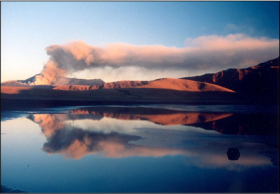 | 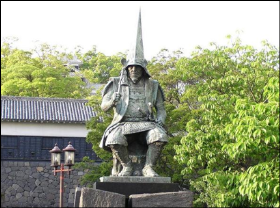 |
Aso Volcano | Statue of Kiyomasa Kato |
How Groundwater Moves in the Kumamoto Region
Groundwater Flow in the Kumamoto Region
The Kumamoto region is encompassed by the bedrock that makes up the foothills of the western side of the Aso Outer Mountain Ring, which creates an enormous basin that is difficult for water to permeate. On top of this bedrock lie pyroclastic flow deposits and sandy soil that collect groundwater and cover much of the lower flat areas within the basin.
There are three main directions that groundwater flows in the Kumamoto region.
The main direction is from the pyroclastic flow plateaus (like the Kikuchi Plateau) that cover the base of the western Aso Outer Mountain Ring. Groundwater is recharged in these plateaus and enters the Mid Shirakawa River Basin where the water collects at a "groundwater pool" where the slope is gentle and flow is slow. The water level gradually lowers until it reaches the springs to the southwest (like Lake Ezu) and continues on further to the Kumamoto Plain to the west. Groundwater also flows southward to the Kumamoto Plain from the Ueki Plateau in the northeast at the base of Mt. Kinpo, and from the mountains of Mifune to the southeast.
How Long Does Groundwater Take to Arrive?
Rainwater permeates the ground and turns into groundwater, but this happens over many years as the water slowly makes its way through the cracks and crevices of the soil layers. While passing through the soil, the water picks up a balance of minerals and carbonation that makes the water both healthy and delicious.
It takes approximately 20 years from the western Aso Outer Mountain Ring and about 5 to 10 years from the Mid Shirakawa River Basin for groundwater to reach the residents of Kumamoto.
The Geology that Creates Our Groundwater
The Kumamoto region is a volcanic plateau consisting of bedrock holding up the groundwater contained in the sedimentary pyroclastic flow deposits that resulted from the four major Aso eruptions. The pyroclastic sedimentary deposits are labeled, from earliest to latest, as ASO-1, ASO-2, ASO-3, and ASO-4. Each of these layers are interspersed with Togawa lava and other layers.
These layers are very porous and are easily penetrated by rainwater. A layer of clay (which is difficult for water to permeate) divides the ASO-3 and ASO-4 layers, creating two layers of groundwater. The Togawa lava layer under the clay layer is full of holes and cracks and acts as a highly porous aquifer for Kumamoto City and the surrounding area.
Tap Water in Kumamoto City
Mineral Water from the Tap
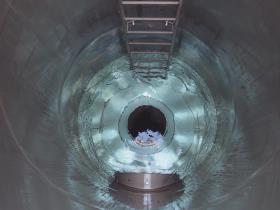 |
Kengun Suigenchi #5 Well |
Groundwater acts as the source for the tap water of all 740,000 residents of Kumamoto
City.
The city uses 98 wells to draw and distribute around 220,000 cubic meters of water throughout the city each day (as of 3/31/2021). Unlike other cities, Kumamoto City doesn't need to rely on dams and water purification plants. Pure groundwater is pumped up from wells where it is treated with the lowest amount of chlorine allowable by law. The water is then sent out to distribution and balancing reservoirs, and then to the homes of Kumamoto residents.
Hakenomiya Suigenchi, where the Kumamoto City Waterworks began over 90 years ago, was selected as one of Japan's Top 100 Modern Waterworks Systems. The Waterworks Museum located there originally housed the pumps for the waterworks and is a nationally registered Tangible Cultural Property.
Kengun Suigenchi is Kumamoto's largest groundwater source. Water flows out naturally from 7 of Kengun's 11 wells. The #5 well has a daily output of 15,000 cubic meters, which is enough to supply over 60,000 people with water.
Safe, Reliable, and Pure Drinking Water
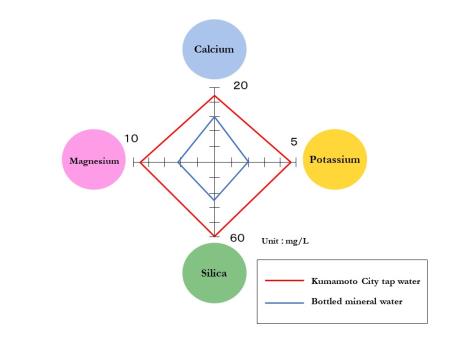
|
Comparison of Mineral Content in Kumamoto City Tap Water and Commercial Bottled Water (as of 9/2/2019) |
Kumamoto City's drinking water has an ideal balance of the minerals needed for healthy living, like calcium and potassium, which makes our water both healthy and delicious. Kumamoto's drinking water also contains a lot of silicon, which helps keep blood vessels in good shape. In essence, Kumamoto's tap water is not your everyday tap water—it's natural mineral water.
The diagram to the left compares some of the minerals found in Kumamoto's tap water with commercial bottled water. You can tell by looking at the graph that Kumamoto's drinking water is equivalent to a high-quality mineral water.
Some countries have mineral water with extremely high mineral content, but these kinds of water tend not to match the tastes of Japanese people. These mineral waters are like luxury items to be enjoyed when the situation permits. In contrast to high mineral-content mineral water, commercial bottled water contains only a tenth of the minerals that Kumamoto tap water has.
Kumamoto's drinking water is natural mineral water that is both delicious and good for you.
The pipes that connect the wells, distribution pools, and balance reservoirs in Kumamoto City have a total length equal to the entire length of the Japanese archipelago(3,550km as of 3/31/2021).This system is monitored and controlled 24/7 by the Waterworks and Sewerage Operations Center.
In order to make sure that the drinking water supplied to everyone is safe, the Waterworks and Sewerage Bureau performs strict water quality inspections on 94 different aspects of the waterworks(as of 4/1/2021), from the well to the faucet.
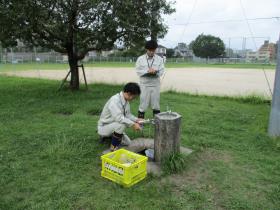 | 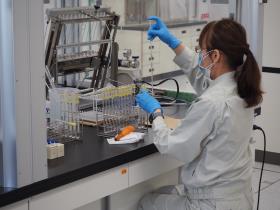 |
Water Sampling | Water Testing |
Current Groundwater Levels
Shrinking Groundwater Recharge Areas
Because groundwater is the result of rainwater and irrigation water seeping into the ground, changes to how land is used can greatly affect groundwater. For example, if land that was once a rice paddy or farm is covered with asphalt or concrete, it becomes harder for rainwater to enter the soil. Lower consumption of rice has led to a decrease in land area used for rice paddies. Increased urbanization has led to more residential areas. These both prevent water from entering the ground, leading to lower levels of new groundwater being generated.
Land where water is easily absorbed, like farms and forests, are called "recharge areas," and land where it is harder for water to enter the ground, like residential and urban areas, are called "non-recharge areas." Increases in non-recharge areas lead to decreases in groundwater.
Changes in Groundwater Levels
Looking at the annual groundwater levels in the Kumamoto region, the levels are at their lowest in May, they rise in the period from June to October as rice paddies are irrigated, then, after irrigation ends in October, water levels gradually decrease into May of the following year.
Although weather conditions affect groundwater levels, long-term comparisons of groundwater levels show an overall decreasing trend since measurements were first taken. However, in recent years, the rate of decrease is beginning to taper off, and except for a few areas, signs of recovery are present.
Current Groundwater Quality
Overall, Kumamoto City groundwater has maintained a high level of quality, but pollution has been detected in some regions. The main causes of pollution are chemical and oil leaks from factories, excessive use of fertilizers on farms, excessive use of livestock waste on fields, and natural causes.
If our precious groundwater becomes polluted to the point where we are unable to use it, finding an alternative source of water would be extremely difficult. Additionally, because groundwater moves slowly, recovery from pollution would take a long time and cost a lot of money. As such, measures to prevent pollutants leaking into the soil are essential to preserving the quality of our groundwater.
Volatile Organic Compound Pollution
Starting around 1985, localized groundwater pollution due to volatile organic compounds like tetrachloroethylene and benzene was discovered. Up until now, we have found pollutants in 25 districts within the city.
Groundwater pollution occurs when hazardous materials used by factories and businesses enter the soil and reach the groundwater. Improvements in water quality have been observed thanks to groundwater purification projects, but there are still some areas where levels exceed environmental standards.
Pollution Due to Natural Causes
Arsenic and fluorine groundwater pollution has been found in areas in southeast Kumamoto City and Ueki. The cause is a natural geological one, and we continue to monitor water quality in these areas.
Nitrate-nitrogen pollution
Nitrate-nitrogen pollution has been found in the Ueki, northern, and northwestern areas of Kumamoto City. All tap water in Kumamoto City is sourced from the ground, but because growing levels of nitrate-nitrogen pollution in some of the groundwater sources continue to be found when observed long-term, finding ways to decrease nitrate-nitrogen levels is a pressing matter.
Nitrate-nitrogen is mainly generated when nitrogen contained in fertilizers, livestock waste, and domestic wastewater is acted upon by microbes in the soil. Nitrate-nitrogen is not readily absorbed by the soil, so whatever is not denitrified or absorbed by plants enters the groundwater.
Consuming water that contains nitrate-nitrogen above a certain amount can lead to a condition (mainly in infants) called methemoglobinemia, where the blood loses its ability to transport oxygen, causing oxygen deficiency.
The History of Government Action in Water Conservation
Groundwater Conservation City Declaration (March 1976)
Spurred on by protests against the building of high-rise apartments in a park next to a water source in Kumamoto City, the Kumamoto City Council passed the Groundwater Conservation City Declaration.
Content of the Groundwater Conservation City Declaration
Issues facing mankind include conservation of the Earth’s limited resources and restoration of its natural environment. Our water resources are not an exception.
Kumamoto City has, over centuries, grown together with nature and quality groundwater, however excessive groundwater use and destruction of the natural environment today has led to pollution and reduced water resources. Thus, this council commits to work with residents to restore and conserve the natural environment and to protect our precious water resources for future generations, and hereby declares Kumamoto City to be a Groundwater Conservation City.
Kumamoto City Council March 22nd, 1976
Groundwater Conservation Ordinance (September 1977)
This ordinance was passed to ensure city residents can enjoy the groundwater resources that they depend on into the future; to guarantee the water needed for drinking and daily life is available through groundwater conservation efforts focused on both water quality and quantity; and to contribute to the health and cultural livelihood of city residents.
This established groundwater as "public water"—a resource shared by city residents—and because responsibility to protect groundwater lies not just with government but also residents and businesses, we now work together towards groundwater conservation through water quality preservation programs, recharge projects, and water conservation campaigns.
Receiving the UN Water for Life Award
Kumamoto City was awarded the UN Water for Life in March 2013. This was in recognition for the over 30 years of work, starting with the Groundwater Conservation Ordinance (1977), that has involved projects that overcame governmental borders (including groundwater recharge programs using rice paddies and watershed conservation forest maintenance programs) and programs by city residents to conserve water that ended up becoming examples for other regions to follow.
Protecting Groundwater Quantity
Maintaining Watershed Conservation Forests
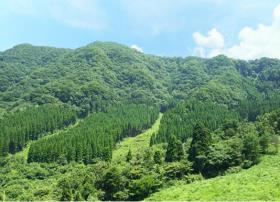 |
watershed conservation forests |
In order to preserve our clear, drinkable groundwater for future generations, we must promote the growth of forests in upstream regions. In Kumamoto City, watershed conservation forests spanning approximately 870 ha (as of March 31, 2021) are maintained in five towns and two villages in upstream regions. In the past, these areas were planted with coniferous trees such as Japanese cedar and cypress, but from 1994, the strategy has shifted to planting mainly broadleaf trees such as zelkova, oak, and maple. Broadleaf trees are better able to replenish water sources and, as of the end of March 2021, 18 varieties of broadleaf deciduous trees and three varieties of broadleaf evergreen trees now account for over 50% of the planting area. These tree planting areas are also used as sites for forestry education where citizens of upstream and downstream municipalities can interact while receiving training as new forestry volunteers, thereby deepening the general public's understanding of watershed conservation forest maintenance.
Replenishing Groundwater Using Rice Paddies
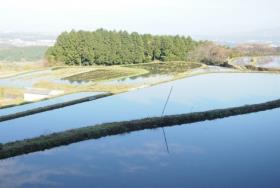
|
| Rice Paddy Flooding |
Paddy fields in the Mid Shirakawa River Basin allow five to ten times more water infiltration than paddy fields in other regions, making this a critical region for groundwater replenishment efforts. However, conversion of these paddies into residential areas or non-paddy crops has led to a steady annual decrease in paddy field area, which is a major factor in the decrease of groundwater volume. In response to this, at a Prefectural Government Meeting in January 2004, Kumamoto City entered into an agreement with local land improvement stakeholders in order to, with cooperation from local farmers, begin converting areas that had been converted into normal farmland back into paddy fields and filling them with water. The target farmland is filled with water for between half a month to four months after being planted with soybeans or carrots. Subsidies are paid out depending on the size of the area to be filled and the period of filling. In recent years, about 250 farmers cooperated in this project, thereby helping to replenish over 10 million cubic meters of groundwater.
Who are land improvement stakeholders?
Land improvement stakeholders are organizations focused on land improvement projects such as the construction of agricultural drainage facilities and agricultural roads, as well as the management, readjustment, reclamation, draining, and disaster recovery of agricultural land.
What is crop change?
Crop change is when a farmer switches from producing one crop to another on the same farmland.
Promoting Rainwater Infiltration
Construction and development impede the infiltration of rainwater into the soil. Therefore, it is necessary to build facilities that enable rainwater infiltration, such as drywells and green spaces. Land developers are obligated to install rainwater infiltration equipment as part of the Kumamoto City Groundwater Conservation Ordinance.
What are drywells?
Drywells allow rainwater that falls on residential properties, etc., to infiltrate into the groundwater. They are an effective tool for restoring groundwater replenishment even as an area urbanizes. Drywells also reduce the amount of rainwater that flows off a site, thereby preventing the flooding of nearby roads. For these reasons, Kumamoto City provides subsidies for the construction of drywells.
Effective Use of Rainwater
Because the effective use of rainwater improves overall conservation of water, Kumamoto provides subsidies for the installation of rainwater reservoirs and storage tanks in people's homes.
What is a rainwater reservoir?
Septic tanks that are no longer necessary due to the laying of public sewer systems, etc., can be re-purposed as rainwater reservoirs, thereby enabling the effective use of rainwater.
What is a rainwater storage tank?
Rainwater that falls on roofs can be routed by gutters into rainwater storage tanks and used to water flowers, etc.
Installation of water retention tanks at elementary and junior high schools
Using rainwater to water flowers, etc., at schools teaches students about groundwater conservation. Rainwater storage tanks have been installed at every elementary and junior high school in Kumamoto City.
The Citizen's Water Conservation Program
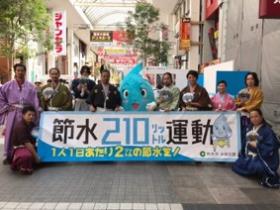 |
| Water conservation event held downtown |
Since 2005, Kumamoto City has involved its citizens in a water saving program in order to form a social environment that promotes water conservation. This program sets a target for daily water consumption per Kumamoto citizen. From 2019, a new target was set to reduce water consumption to 210 liters/day (the 2016 average among major cities in Kyushu) by 2024.
The summer months of July and August, when water use is at its highest, were designated as a critical period for water saving. During these months, the city announces the amount of per-citizen water use on a daily basis and promotes water-saving behavior and the sale of water conservation equipment through affiliated stores.
History of the Citizen's Water Conservation Program
In keeping with the Kumamoto Save Water Action Plan, which was proposed at the 2004 Kumamoto Water Saving Promotion Partnership Meeting, efforts for water conservation, particularly during the summer months of heavy water use, have been expanded under the Society for Water Conservation Experiment started in 2005 (which was later renamed Water Conservation Month in 2008). From 2011, July and August were designated as a critical period in the summer for water saving and the Citizen's Water Saving Program was expanded to be a year-round effort.
Daily Water Use Per Citizen of Kumamoto
Efforts to reduce the amount of daily water use per citizen first started in 2002, with the goal of a 10% reduction to 230 liters/day from the then-current average value of 254 liters/day. This goal was achieved twice consecutively in 2012 and 2013.
However, compared to the average amount used by major Kyushu cities, Kumamoto City still tends to use more than its share of water. For this reason, the target for water use was reduced to 218 liters/day in 2014, and again to 210 liters/day in 2019.
Affiliate Stores Selling Water Conservation Products
Stores carrying water conservation equipment such as water-saving toilet tank weights and bath pumps are registered by Kumamoto City as Affiliate Stores Selling Water Conservation Products, and play an important role in helping citizens save water.
Currently, 25 stores in Kumamoto City have been registered (as of February 2022).
Protecting Groundwater Quality
Monitoring Groundwater Quality
Surveys are continuously performed to accurately gauge the quality of groundwater. There are three types of surveys that measure different aspects of quality, and appropriate survey sites are selected based on the type of survey to be performed.
(1) Surveys of the general condition of regional groundwater
(2) Surveys to confirm the scope of newly-discovered pollution
(3) Continuous surveys to monitor changes in polluted areas, etc.
Groundwater Purification and Pollution Prevention Measures
When groundwater pollution is found, the city first instructs well owners regarding the safety of the water for drinking. Then, purification or monitoring measures are carried out depending on the cause and extent of the pollution.
To date, 25 areas with polluted groundwater have been confirmed in the city, and purification measures are being implemented at six of them (purification is being handled by the city in one case and by the polluters or land-owners in the remaining five). Areas in which purification is not being implemented are continuously monitored to determine when natural decomposition of the pollutants has reduced levels below standard environmental levels.
In addition, in order to prevent new pollution, the city provides guidance to businesses that stockpile or use hazardous substances and oil. This guidance covers topics such as standards for creating facilities and proper management practices for these substances.
Nitrate-Nitrogen Reduction Measures
Groundwater pollution due to nitrate-nitrogen has a wide variety of causes and typically impacts a wide area. As it is extremely difficult to purify groundwater once it has been polluted in this manner, most countermeasures focus on handling potential sources of pollution.
Specific pollution sources and their countermeasures include:
(1) Fertilizers - Appropriate fertilizer application, promotion of green agriculture in Kumamoto, etc.
(2) Livestock waste - Appropriate processing of livestock waste, etc.
(3) Domestic wastewater - Building wastewater treatment facilities, etc.
We have implemented the above measures and set targets for each measurement item in order to reduce nitrate-nitrogen.
Particular effort has been given to the issue of livestock waste, leading to the development of the Tobu Compost Center, which began supplying compost in April 2019. The Tobu Compost Center produces compost from solid livestock waste and sprays it in proper quantities on fields, thereby reducing the impact of nitrate-nitrogen on the groundwater.
As the issue of reducing nitrate-nitrogen must be tackled all throughout Kumamoto, we collaborate with the prefectural government, various Kumamoto municipalities, and agricultural organizations to reduce the concentration of nitrate-nitrogen in the groundwater.
Promoting the Kumamoto Water Brand
For Kumamoto City, water is not only an essential resource to be preserved for our survival—it is also an asset that can be used to make the city a more appealing place. For this reason, we have crafted a narrative around the "Kumamoto Water Brand," in which our pure groundwater helps create much of Kumamoto's diverse appeal, from its vibrant natural environment to its thriving agriculture and bountiful sightseeing locales. In addition, Kumamoto citizens take part in groundwater preservation activities to proactively spread this brand throughout Japan and the world.
Environmental Education, Lifelong Education
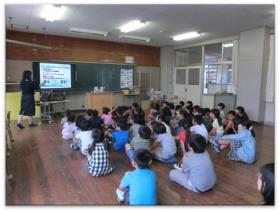 |
| Water conservation class held at elementary school |
Kumamoto City employees visit regions, schools, companies, etc., to promote Kumamoto's water conservation efforts and its groundwater. At elementary schools, we carry out hands-on water conservation activities such as study sessions as part of the Elementary School Water Conservation Challenge, and install water-saving flow limiters on school faucets. We have also created a variety of groundwater-related activities for the general public provided via special on-site workshops.
Kumamoto Water Certification
This program was started in 2008 as Japan's first water-related regional certification program. Through this certification, we promote public awareness of water issues and water culture, share the appeal of Kumamoto City and its groundwater, and raise awareness regarding groundwater preservation. The Level 3 test, a mail-in test that can be taken from home or at school, is particularly popular, with about 50,000 people certified so far (mainly Kumamoto City elementary and junior high school students).
Kumamoto Mizumori
Many people in Kumamoto are involved in activities to protect its water and water culture and promote their appeal. These people are registered as "Kumamoto Mizumori" (water protectors) in order to build out a network of like-minded individuals while collecting and providing information about water-related activities to protect water and use it efficiently.
Examples of mizumori include people who clean and give tours of springs in their area, university professors who research groundwater, restaurant owners who promote Kumamoto's water, writers of songs about water, and so on. We support the continuation of these activities in various fields and designate their practitioners as mizumori in order to earn them further attention.
Kumamoto Water Heritage Assets
In order to preserve the culture and customs of the water of Kumamoto City for future generations, we register related assets as heritage assets for our citizens. Tangible and intangible assets are eligible for registration, such as spring water, food, feats of civil engineering, festivals, traditions, etc.
Nominations for Kumamoto Water Heritage Assets are solicited from all citizens and registered after screening by the Kumamoto Water Heritage Committee. To date, 92 assets have been registered.
Requirements for a Kumamoto Water Heritage Asset
1 Tangible and intangible assets related to water. Examples: springs, lakes, ponds, rivers, wells and irrigation systems, gardens, food,
traditional local customs, art, culture and entertainment, dialects, folk songs, folk tales, etc.
2 Assets within Kumamoto City. Deceased people with a connection to the city are also eligible.
3 Assets that constitute or characterize the city's water customs and cultures.
4 Assets that utilize water to contribute to the city's appeal.
Downtown Water Fountains
With the opening of the new Shinkansen line connecting all of Kyushu in the spring of 2011, Kumamoto City constructed water fountains where visitors could drink natural groundwater (tap water) at various locations in the city between the new Shinkansen station and Kumamoto Castle areas in order to promote Kumamoto's image as a city with excellent groundwater. All of these fountains let visitors enjoy Kumamoto's delicious groundwater and are installed around the city so visitors can get a drink while sightseeing.
100 Remarkable Waters of the Heisei Era
Kumamoto Prefecture is often called a “water wonderland” because it boasts more than 1,000 springs. The Ministry of the Environment selected 100 Remarkable Waters for the Showa and Heisei Eras, among which eight locations in Kumamoto Prefecture are included, tying it with Toyama Prefecture for the most represented region on these lists.
Two locations in Kumamoto City—the Suizenji-Lake Ezu Spring Group and the Mt. Kinpo Spring Group—have been selected for the 100 Remarkable Waters of the Heisei Era.
What are the 100 Remarkable Waters of the Heisei Era?
The 100 Remarkable Waters of the Heisei Era is a list of significant locations selected from the many locations in Japan where water or water environments are a major part of local life. Locations where local residents take an active role in continuously preserving their water environment are particularly likely to be included. This list, as with its predecessor from the Showa Era, is selected by the Ministry of the Environment and is designed to further promote preservation of water environments.
What is the Suizenji-Lake Ezu Spring Group?
Lake Ezu is a place that citizens love to visit for leisure. It was also once the site of Lord Hosokawa's tea house, which later became Suizenji Jojuen. It is also the site of the Kengun Suigenchi, the city's largest water source, which supplies approximately one quarter of the city's tap water.
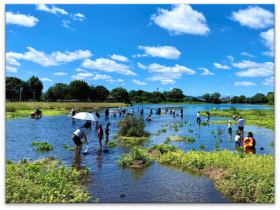 | 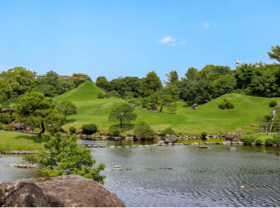 |
Lake Ezu | Suizenji Jojuen |
What is the Mt. Kinpo Spring Group?
This refers to the 20 springs (19 in Kumamoto City and one in Tamana) scattered throughout the Mt. Kinpo Mountain Range. This area also includes Tensui Pond, whose water was presented to the Meiji Emperor when he visited Kyushu, as well as Unganzenji Temple, home to the cave where Musashi Miyamoto wrote The Book of Five Rings.
Initiatives for Wide-Area Cooperation
As groundwater preservation must be enacted over a wide area that spans multiple municipalities, the Kumamoto region (Kumamoto City and 10 neighboring municipalities) works with the prefectural government and the governments of relevant municipalities to preserve groundwater.
In the city, the Rice Paddy School promotes exchange between the residents of the Mid Shirakawa River Region, a critical area for groundwater replenishment, thereby deepening mutual understanding among residents of different regions. Other initiatives include the Watershed Conservation Forest Creation Volunteer Training Course, in which citizens learn forestry-related activities like tree planting and thinning in order to promote citizen-led conservation of forests on upstream groundwater sources.
Furthermore, we engage in groundwater preservation activities throughout the Kumamoto region by working with the Kumamoto Groundwater Foundation, which was founded on April 1, 2012.
The Kumamoto Groundwater Foundation was founded in 2012 for wide-ranging and inter-organizational preservation of groundwater as the basis of life in Kumamoto. The foundation runs four charitable projects to this end: research into the mechanisms for groundwater flow, groundwater quality preservation, groundwater maintenance, and awareness activities.
Its members endeavor to pass on groundwater—the treasure of Kumamoto—to future generations by carrying out groundwater preservation projects that provide benefits to and enjoy cooperation from residents, businesses, and government entities all throughout Kumamoto.
Interested in Participating in Groundwater Preservation Projects?
Example 1: Kumamoto Water Education Society
A volunteer organization whose members agree with the objectives of the Kumamoto Groundwater Foundation and want to support groundwater preservation activities.
The society disseminates information on upcoming symposiums and other groundwater preservation-related information. We look forward to your participation.
Example 2: Rice Paddy Owner Program
Submerging rice paddies when growing rice greatly contributes to groundwater preservation. Join us in making rice and preserving our groundwater while participating in rice planting and harvesting.
This fun activity helps to protect Kumamoto's agriculture and groundwater while also deepening your relationship with your family or colleagues.
Agreement for Emergency Wells Based on Lessons Learned
The Emergency Wells Agreement was created together with well-owning businesses in Kumamoto City after one of the lessons learned from the Kumamoto Earthquakes: citizens must have quick access to water after a natural disaster.
Under this agreement, if a natural disaster disrupts water supply to a wide area, these businesses pledge to allow citizens to use these wells free of charge. Depending on the providing well, the water pumped from it may be used for drinking or put to household use, e.g., to flush toilets. Water is approved for drinking after a city water quality inspection.
More and more companies are joining to help with the emergency response in case of a disaster. Please check the latest information services for your region on the Kumamoto City website.